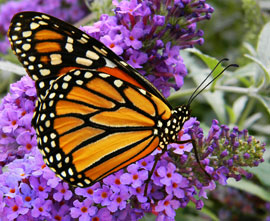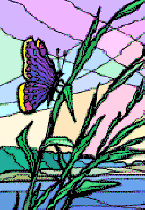
Monarchs-And-Milkweed.com
Raising Monarchs
(Rose Franklin's Perennial &
Butterfly Farm)
|
Monarchs-And-Milkweed.com |
![]()
|
To raise Monarch butterflies you will need Monarch eggs or
caterpillars, healthy milkweed (Asclepias) plants, and a rearing
chamber. A small aquarium with a screened lid will serve this purpose. The
mesh Popups we offer on the 'Popup Cages' page are excellent for rearing
caterpillars as they are predator-proof, easy to clean, and easy to store
(they collapse). Common Milkweed (Asclepias syriaca), Swamp Milkweed (Asclepias incarnata), or Tropical Milkweed (Asclepias curassavica) are among the best choices to be utilized as a food source for your caterpillars. Since the caterpillars will require fresh milkweed leaves every day, your milkweed source should be near by. To begin your rearing project, cut a few leaves from a milkweed plant. Rinse the leaves under clean water and then wipe them dry with a paper towel. Do not put wet foliage in the cage as this could cause mold to form inside the cage. Wash your hands after handling milkweed foliage. Its sap can be harmful, especially if it comes into contact with your eyes. Put the milkweed leaves in the rearing chamber and then carefully add the Monarch caterpillars. Apply the lid so the caterpillars cannot get out. If you are raising Monarchs beyond early August, I highly suggest that you sanitize the milkweed leaves that are being fed to caterpillars. You'll find instruction for doing this in the next article (please scroll down). Replenish the caterpillars’ food supply (milkweed) daily and be sure they have an adequate supply of fresh leaves at all times. Caterpillars do not require a source of water as they get all the water they need from the foliage they consume. Caterpillar frass (droppings, poop) should be cleaned from the rearing chamber on a daily basis to limit the chance of disease. Even in a very clean rearing environment, watch your caterpillars closely for signs of bacterial infection or virus. If any of the caterpillars look or behave abnormally, turn blackish in color or appear deflated, remove those caterpillars immediately and keep them segregated from the others. Bacterial infections and viruses can kill the infected individuals and most are highly contagious. Monarch caterpillars grow fast and
molt (shed their skin) five times during their growth. When they are soon
going to molt, they generally crawl away from the milkweed and sit still
for hours (even up to a full day). Do not gather these caterpillars up and put them back on the
milkweed, thinking they just wondered off and couldn't find their way back
to their food. When it's time to molt, they won't be hungry, and really
should not be handled. The transformation from caterpillar to pupa (chrysalis) must be one of the most fascinating displays nature has to offer. It begins shortly after the caterpillar’s antennae begin to look zigzagged (crinkled, wrinkled). By the time the caterpillar is ready to pupate, it looks somewhat deflated. At this point though, the deflated look is normal and to be expected. When the transformation from caterpillar to chrysalis is complete, the chrysalis will be only about 1” long. You will wonder how a 2¼” caterpillar could fit inside such a small container. The chrysalis will be very soft at first and at this point, and should not be touched. Once it hardens, it will be jade green with a metallic gold band near the top and metallic gold dots toward the bottom. Motionless, the chrysalis hangs for 10 to 14 days. Inside a remarkable change is taking place though: a not-so-cute caterpillar is becoming a beautiful Monarch butterfly. The day before the Monarch emerges from its chrysalis, it turns transparent and you can actually see the Monarch’s orange and black wings inside. Once the chrysalis cracks open, it takes less than 30
seconds for the butterfly to completely emerge from its shell. Immediately
following emergence, the Monarch’s wings are small and its body is short
and plump. Within 90 minutes or so, the Monarch is full-sized and able to
fly. Weather permitting, it should be set free outdoors within a few
hours.
|
![]()
by Rose Franklin
The best place
to find healthy common milkweed is in a farmer’s field or along a
highway where it was mowed off earlier in the season and now has a
second-growth of tender, lush, green foliage. This is prime stuff to
utilize as caterpillar food. Another location where lush, green milkweed
might be found is along a highway that is partially shaded by trees.
Milkweed that has spent the summer in a lot of shade will generally be a
lot greener and healthier than milkweed that has been growing in full sun. No matter where
you gather your milkweed from, if you are gathering it from mid August
thru September, it should be sanitized before it is fed to caterpillars.
By then, many milkweed leaves will be dotted with disease-causing
pathogens (germs) and unless those pathogens are removed, they will be eaten by
the caterpillars. Unfortunately, these disease-causing pathogens can't be seen. They are
microscopic. But if these pathogens are consumed by caterpillars, they
might likely cause the caterpillars to become ill.
Some pathogens will even cause disease that will kill the caterpillars. To rid the
milkweed of pathogens that could cause disease in the caterpillars, the
milkweed must be sanitized. To sanitize common milkweed leaves, cut the
leaves from the stems. Dip them into a solution of 10% Clorox and 90%
water, thoroughly covering both sides of the leaves. Let the sanitizing
solution on the leaves for 2 minutes. Then rinse and rinse and rinse again
in clean water. Wipe (don’t pat) the leaves dry with paper towels or a
fabric softener-free cloth. Once the leaves
are dry, they are ready to be fed to the caterpillars. Fresh leaves
should be given to the caterpillars every day, with morning being the best
time to replenish the food supply. *** I, Rose
Franklin, sanitize
all the milkweed that is going to be fed to our caterpillars, not just in
August and September but from spring thru fall. |
![]()
Raising Healthy Monarchs in the Classroom in Fall Rearing Monarchs in the classroom is the same as rearing them anywhere else so the instructions above should be read thoroughly before you begin your rearing project. This means you begin by first sanitizing the rearing cage, the table or countertop where the cage is going to sit, and all utensils that might be used in raising your caterpillars. Cleanliness is important but so too is the health of the host plant being fed to the caterpillars. We have all heard that “you are what you eat.” While this saying holds much merit for humans, it is more true for butterflies, and especially during the larval stage of development. In the case of humans, what we eat is important, but also of importance is exercise, emotional state, and level of stress. With caterpillars though, it’s all about the food; for all caterpillars do is eat. Eat and poop. Their health doesn’t depend upon how much they exercise or what they think about during the course of a day. It depends essentially upon what is entering and exiting their stomachs. Milkweed varies
in nutritional quality based upon species and age. For teachers who are
raising Monarchs in the classroom in September, the issue of milkweed age
in an important consideration. If the caterpillars are being reared on
Common Milkweed (Asclepias syriaca),
they might well be malnourished. How do
I know this? By
September, Common Milkweed is headed toward dormancy and its leaves are no
longer packed with high-quality nutrients. Malnourished, the
caterpillars’ immune system will be weakened and resistance to disease
will be compromised. When the immune system is not strong enough to fight
off the pathogens that cause bacterial, viral, parasitic, and fungal
infections, disease is more prone to develop. Because the
health of the caterpillar so much depends upon the health of the larval
food, I suggest that if you are intending to raise Monarchs in the
classroom in September, you also plan on having large, potted Tropical
Milkweed (Asclepias curassavica)
plants to utilize as larval food. To have large plants in September, you
can either sow Tropical Milkweed seeds in May, or you can
purchase small potted plants in June and then raise them to maturity. My
suggestion is that you keep the plants in pots, moving them to slightly
larger pots as necessary for continued root growth. The
plants should be grown outdoors, preferably in full sun. Since Tropical
Milkweed does not go dormant until long after Common Milkweed does,
Tropical should be the species of choice in rearing Monarch caterpillars
in September. And to insure that the foliage is as nutritious as possible,
the leaves should not be cut from the stems (this, because Tropical
Milkweed foliage wilts quickly once cut from the plant). Instead, potted
plants should be used to feed the caterpillars, replacing devoured plants
with fresh, lush ones, as necessary. Will using
Tropical Milkweed as the food plant guarantee healthy Monarchs? No. Quite
frankly, it is much easier to raise Monarchs (and other butterfly species
too) in June, July, and August, than it is to raise them in September. During the summer months, disease-causing pathogens, parasites,
parasitoids, and predators all multiply exponentially in nature. By
September, they are in the air, on plants, on adult butterflies,
everywhere. With an abundance of pathogens abound, there is more chance
for caterpillars to become infected. Tropical
Milkweed, because it contains more nourishment in September
than Common Milkweed does, will certainly aid the caterpillars in keeping
their immune systems strong. But with disease causing pathogens
dramatically increased in number by September, it is difficult for the
caterpillars to escape infection (unless the milkweed is sanitized to kill
off the pathogens). Most teachers are able to raise healthy Monarchs, even in September, but some do periodically encounter problems. If you have experienced problems in the past, and raised your caterpillars on Common Milkweed that was less than top-quality, I suggest you either find healthier Common Milkweed (second-growth) or try rearing your caterpillars on Tropical Milkweed. The stronger the caterpillars’ immune systems, the more likely it is that they will survive to become healthy adults. |
![]()
![]()
|
|
| If you are raising
Monarch butterflies, it would be beneficial for you to know what OE is and
to take precautions to protect your caterpillars from becoming infected
with OE. I created a slide presentation entitled 'Raising OE-Free Monarchs' to share with all who raise butterflies in the home or in a classroom. I suggest that you download the PDF to your computer so you can view it at your convenience. Even if you're not raising Monarchs (one of just a few butterflies that can contract OE), but you are raising other butterfly species, you will likely find valuable information on operating procedures which will aid in reducing the transmission of many other insect diseases in your rearing operation. And sometimes, making the simplest of changes can greatly increase your success in raising healthy butterflies. |
![]()
|
Glossary of Butterfly Terminology Abdomen Antenna
(singular) Caterpillar Chrysalis
(singular)
Eclose Egg Exoskeleton Filaments Frass Hemolymph Instar Larva
(singular) Lepidoptera Molting Oviposit Pheromone Proboscis Prolegs Pupa
(singular) Pupate Spinneret Spiracles Thorax
|
![]()

|
Rose Franklin's
Perennials (814)
422-8968
Email: MilkweedLady@aol.com |
|
|
Copyright © 2002-2024. [Rose Franklin's Perennials]. All rights reserved.
Revised: February 15, 2024